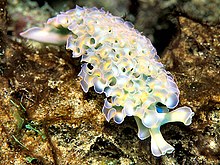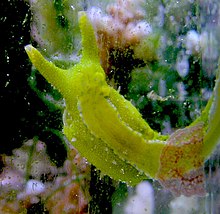Sacoglossa
| Sacoglossa Temporal range: Eocene – Present |
|
|---|---|
 |
|
| Elysia crispata, a shell-less species in the family Placobranchidae | |
 |
|
| Oxynoe olivacea, a Mediterranean shelled sacoglossan in the family Oxynoidae | |
| Scientific classification | |
| Kingdom: | Animalia |
| Phylum: | Mollusca |
| Class: | Gastropoda |
| (unranked): |
clade Heterobranchia clade Euthyneura |
| Diversity | |
| 284 species | |
| Synonyms | |
|
Ascoglossa Bergh, 1876 |
|
clade Euthyneura
clade Panpulmonata
clade Sacoglossa
Ihering, 1876
Ascoglossa Bergh, 1876
Sacoglossa, commonly known as the sacoglossans or the "sap-sucking sea slugs", are a clade of small sea slugs and sea snails, marine gastropod mollusks that belong to the clade Heterobranchia. Sacoglossans live by ingesting the cellular contents of algae, hence the adjective "sap-sucking".
Some sacoglossans simply digest the fluid which they suck from the algae, but in some other species the slugs sequester and utilize within their own tissues living chloroplasts from the algae they eat, a very unusual phenomenon known as kleptoplasty, for the "stolen" plastids. This earns them the title of the "solar-powered sea slugs", and makes them unique among metazoan organisms, for otherwise kleptoplasty is known only among single-celled protists.
The Sacoglossa are divided into two clades: the shelled families (Oxynoacea) and the shell-less families (Plakobranchacea). There are four families of shelled species: Cylindrobullidae, Volvatellidae, Oxynoidae and Juliidae, the bivalved gastropods. The shell-less Plakobranchacea are grouped in six families, divided between two clades ("superfamilies"), the Plakobranchoidea and the Limapontioidea. All saccoglossans are distinguished from related groups by the presence of a single row of teeth on the radula. The teeth are adapted for the suctorial feeding habits of the group.
...
Wikipedia
